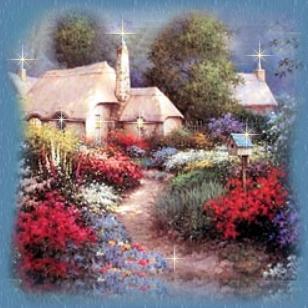 |
 

Grandmother's Cottage Garden

"Guided by my heritage of love and beauty...
in search of my mother's garden,
I found my own."
~Alice Walker~
May is a good month to honor our mothers and grandmothers.
Our Meowmie honors her two grandmothers who loved cottage style
gardens. She has planted several of her grandmothers' favorite
cottage flowers in her several borders. She has foxgloves,
hollyhocks,delphiniums, coreopsis, peonies, dianthus, iris,
lavender, gladiolas, heliotrope, bellflowers, poppies,
sea lavender, coral bells, ferns, pansies, maiden pinks,
purple coneflowers, daisies, aquilegia, ferns, day lillies,
violets, hibiscus, heuchera, veronica and roses.
No cottage garden would be complete without roses. :-)

Cottage gardens are more than just a concept. They combine a variety
of flowers and plants. England is famous for its charming cottage
gardens that have thrived for centuries. Small, thatch-roofed cottages
were surrounded with flower beds overflowing with colorful plants.
Flower beds in a cottage garden were usually quite small, often only
the tiny space between the front of the cottage and the road. Most
original cottage gardens were surrounded by a wall or hedge. While the
cottage garden may have been small, it was packed with plants. There
was usually no design when planting a cottage garden. Plants were placed
wherever there was room for them. Because the garden was so small,
plants were placed very close together, creating a riotous display of
flowers and foliage that provided color from very early in the season
right through to fall. There are many plants that were traditionally
planted in cottage gardens and have come to be loosely classified as
"cottage flowers." They include biennials, perennials, annuals and roses.
Butterflies, birdhouses, picket fences, tall cutting flowers, bird baths
water fountains, goldfish pond, vegetables, herbs, wildflowers, stones
stone walls, architectural elements, bird feeders, hanging baskets, moss,
secret paths, arbors, ivy, waddle fences, fuchsias, hummingbirds, roses,
trellises, garden benches, porch swings, ferns, wildlife are also elements
in a cottage garden. Cottage gardens are "Havens of Rest".

One of the plants long associated with cottage gardens is the hollyhock.
Hollyhock forms a mound of rounded leaves a couple of feet high and wide.
It bears tall spikes of single, semi-double or double flowers. There's a
wide range of flower colors including white, yellow, pink, red, rose,
lavender, peach, orange and black. Most varieties grow 5 to 7 feet tall.
Hollyhock is generally grown as a biennial, meaning it blooms the second
season from planting. Hollyhock often self-sows to return year after year
in the garden. The history of the Hollyhock is shrouded in mystery. They have
been in gardens for so long (since the early Middle Ages) that no one can connect
them with any known wild species.


Another biennial grown in cottage gardens is foxglove.
It's also a spiky plant, but with flower stems only about half as tall
as hollyhock. The flower spike carries numerous tubular flowers on
flower stems about 2 to 3 feet tall. Flower colors includes white,
yellow, red, rose and pink. Many varieties have speckled or spotted
throats. Foxglove forms a low mound of felty foliage. To always have
foxglove in the garden, plant new plants in the garden each spring.

Your activity for May is to mew about what you have
grown in your own gardens, or send in your research, or
graphics that you can find on cottage gardening.
Mew to us, Sophie and Shirley by using the mail button
below. Also, send in your biographies for our "Getting
to Know You" pages. Remember, the other monthly activities
are always open to garden in.





http://www.christcenteredart.com

|












